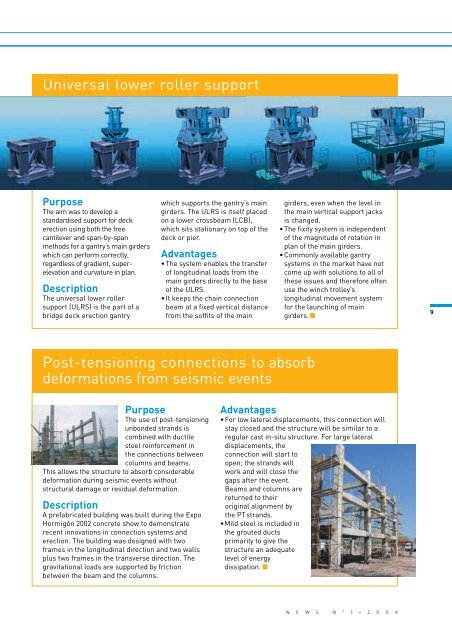VSL's innovations Dampers on test Penny's Bay in HK
VSL's innovations Dampers on test Penny's Bay in HK
VSL's innovations Dampers on test Penny's Bay in HK
You also want an ePaper? Increase the reach of your titles
YUMPU automatically turns print PDFs into web optimized ePapers that Google loves.
Universal lower roller support<br />
Purpose<br />
The aim was to develop a<br />
standardised support for deck<br />
erecti<strong>on</strong> us<strong>in</strong>g both the free<br />
cantilever and span-by-span<br />
methods for a gantry’s ma<strong>in</strong> girders<br />
which can perform correctly,<br />
regardless of gradient, superelevati<strong>on</strong><br />
and curvature <strong>in</strong> plan.<br />
Descripti<strong>on</strong><br />
The universal lower roller<br />
support (ULRS) is the part of a<br />
bridge deck erecti<strong>on</strong> gantry<br />
which supports the gantry’s ma<strong>in</strong><br />
girders. The ULRS is itself placed<br />
<strong>on</strong> a lower crossbeam (LCB),<br />
which sits stati<strong>on</strong>ary <strong>on</strong> top of the<br />
deck or pier.<br />
Advantages<br />
• The system enables the transfer<br />
of l<strong>on</strong>gitud<strong>in</strong>al loads from the<br />
ma<strong>in</strong> girders directly to the base<br />
of the ULRS.<br />
• It keeps the cha<strong>in</strong> c<strong>on</strong>necti<strong>on</strong><br />
beam at a fixed vertical distance<br />
from the soffits of the ma<strong>in</strong><br />
Post-tensi<strong>on</strong><strong>in</strong>g c<strong>on</strong>necti<strong>on</strong>s to absorb<br />
deformati<strong>on</strong>s from seismic events<br />
Purpose<br />
The use of post-tensi<strong>on</strong><strong>in</strong>g<br />
unb<strong>on</strong>ded strands is<br />
comb<strong>in</strong>ed with ductile<br />
steel re<strong>in</strong>forcement <strong>in</strong><br />
the c<strong>on</strong>necti<strong>on</strong>s between<br />
columns and beams.<br />
This allows the structure to absorb c<strong>on</strong>siderable<br />
deformati<strong>on</strong> dur<strong>in</strong>g seismic events without<br />
structural damage or residual deformati<strong>on</strong>.<br />
Descripti<strong>on</strong><br />
A prefabricated build<strong>in</strong>g was built dur<strong>in</strong>g the Expo<br />
Hormigón 2002 c<strong>on</strong>crete show to dem<strong>on</strong>strate<br />
recent <str<strong>on</strong>g><strong>in</strong>novati<strong>on</strong>s</str<strong>on</strong>g> <strong>in</strong> c<strong>on</strong>necti<strong>on</strong> systems and<br />
erecti<strong>on</strong>. The build<strong>in</strong>g was designed with two<br />
frames <strong>in</strong> the l<strong>on</strong>gitud<strong>in</strong>al directi<strong>on</strong> and two walls<br />
plus two frames <strong>in</strong> the transverse directi<strong>on</strong>. The<br />
gravitati<strong>on</strong>al loads are supported by fricti<strong>on</strong><br />
between the beam and the columns.<br />
girders, even when the level <strong>in</strong><br />
the ma<strong>in</strong> vertical support jacks<br />
is changed.<br />
• The fixity system is <strong>in</strong>dependent<br />
of the magnitude of rotati<strong>on</strong> <strong>in</strong><br />
plan of the ma<strong>in</strong> girders.<br />
• Comm<strong>on</strong>ly available gantry<br />
systems <strong>in</strong> the market have not<br />
come up with soluti<strong>on</strong>s to all of<br />
these issues and therefore often<br />
use the w<strong>in</strong>ch trolley’s<br />
l<strong>on</strong>gitud<strong>in</strong>al movement system<br />
for the launch<strong>in</strong>g of ma<strong>in</strong><br />
girders. ■<br />
Advantages<br />
• For low lateral displacements, this c<strong>on</strong>necti<strong>on</strong> will<br />
stay closed and the structure will be similar to a<br />
regular cast <strong>in</strong>-situ structure. For large lateral<br />
displacements, the<br />
c<strong>on</strong>necti<strong>on</strong> will start to<br />
open; the strands will<br />
work and will close the<br />
gaps after the event.<br />
Beams and columns are<br />
returned to their<br />
orig<strong>in</strong>al alignment by<br />
the PT strands.<br />
•Mild steel is <strong>in</strong>cluded <strong>in</strong><br />
the grouted ducts<br />
primarily to give the<br />
structure an adequate<br />
level of energy<br />
dissipati<strong>on</strong>. ■<br />
N E W S N ° 1 • 2 0 0 4<br />
9





